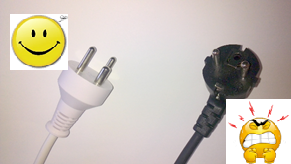Working safely with electricity

230 volts mains electricity
All electrical equipment must be earthed via the mains cable. This provides better protection from electric shock and accidents even when there may be some leakage in the apparatus.
Therefore: All laboratory apparatus must have a Danish 3-pin mains plug that is earthed, 2 round pins and one flat “earth “pin below!
· Mains cables with 2-pin plugs are not earthed and must NOT be used (see picture). Throw them away. The correct plugs can be obtained through the electronic workshop (Incuba)
· Plugs and cables must be in perfect condition. Users must make sure that the mains connections, i.e., mains socket and apparatus socket are not damaged (the plug pins are intact and the cable insulation is not torn, etc.).
Note also that:
· cables must be of robust quality, without holes or burn marks from hot plates, etc.
· cables must be attached firmly to the mains and to the apparatus.
When in doubt about the quality of the mains cable, discard it and get a new one.
Please note: Leakage circuit breakers cannot handle everything. They can only ensure against leakage from 230 volt mains connection to earth, and may thus prevent an electric shock. Contact with both “active” mains cables will give many kilowatts for hours. Leakage circuit breakers do not protect against errors in the high voltage output.
High voltage connection to electrophoresis apparatus
· Cables must be of high quality and always have approved “safety plugs”
· Cables and gel apparatus must have insulation against more than 1000 Volt (even 1500 Volt.)
In other words:
· Silicon rubber cables that give a continuous heat should be used
· Avoid rubber tubing (they crack) and thin plastic tubing that melts in contact with the edge of a hot plate.
· Never use transformers, adjoining cables or adaptors that can transform the approved safety sockets to those that are less safe. They are dangerous and must be discarded.
· Cables and gel apparatus must be capable of taking the same current as the attached safety plug.
Safety plugs and sockets of the correct type
Only two types of safety plugs are allowed. Other types are not allowed in the laboratories.
Note that both types have solid insulation sleeves so that the plug pins cannot be touched directly.
· Ordinary 4 mm safety plugs that are standard for most equipment. They are internationally approved and are suitable for about 1000 volt when they are dry.
· 2 mm safety plugs with a longer, stronger covering, suitable for up to 1500 volt.
Please note that plugs with resilient coverings are unsuitable as they are only for low voltage (to minimise short circuit). Under no circumstance must they be used or be available! The same applies for old-fashioned banana plugs (as well as sockets and extension cables). They must be discarded as they do not meet the regulations and are far too dangerous.
Safe power supplies
· Power supplies must of course have the correct sockets, corresponding to the correct safety plug.
· 4 mm safety sockets have mouldings suitable for the plugs covering.
· 2 mm safety sockets are deeper, corresponding to the long plug’s bigger covering.
· Equipment with old-fashioned sockets for banana plugs must be discarded.
· Power supplies with high voltage current must be insulated with respect to “earth” or have a safety circuit that breaks when earthed (this can be checked by technicians).
New equipment
All new equipment must be CE-marked (this has been obligatory since 1997). However, a CE mark is not an approval (as many think), but merely the factory’s statement that the equipment is safe to use. You must therefore be critical and evaluate the equipment before buying!
Note, that Bio-Rad, for example, uses a “longer, modified, banana plug” without a solid covering, with accompanying lowered sockets in their power supplies.
Maybe this looks reliable when their equipment is assembled, but it is especially dangerous when used together with other equipment having the correct safety sockets.
It is stressed that:
· banana plugs with exposed electrical parts must be discarded immediately
· plugs with resilient coverings must not be used
· high voltage plugs and sockets must be the standard safely type with solid coverings
· all electric laboratory apparatus must be earthed, i.e., mains plugs must be Danish with 3pins
· you should contact the electronic technicians before buying new equipment to make sure that it is in agreement with the above rules.